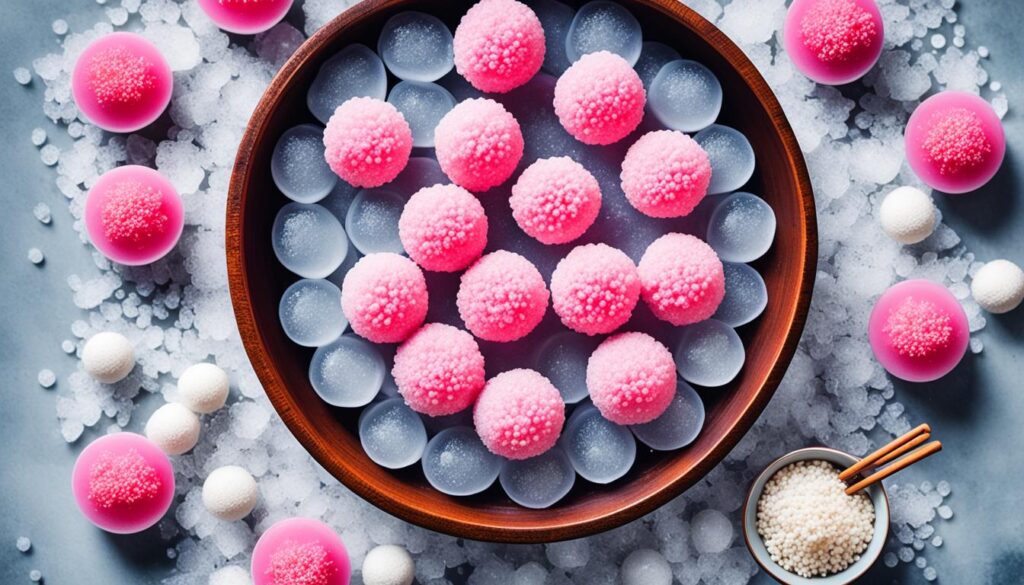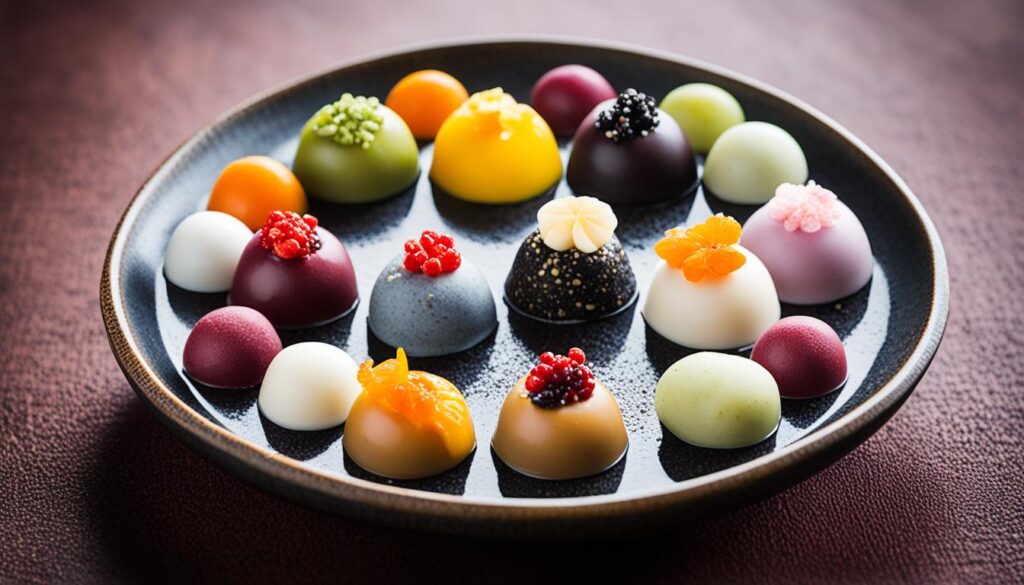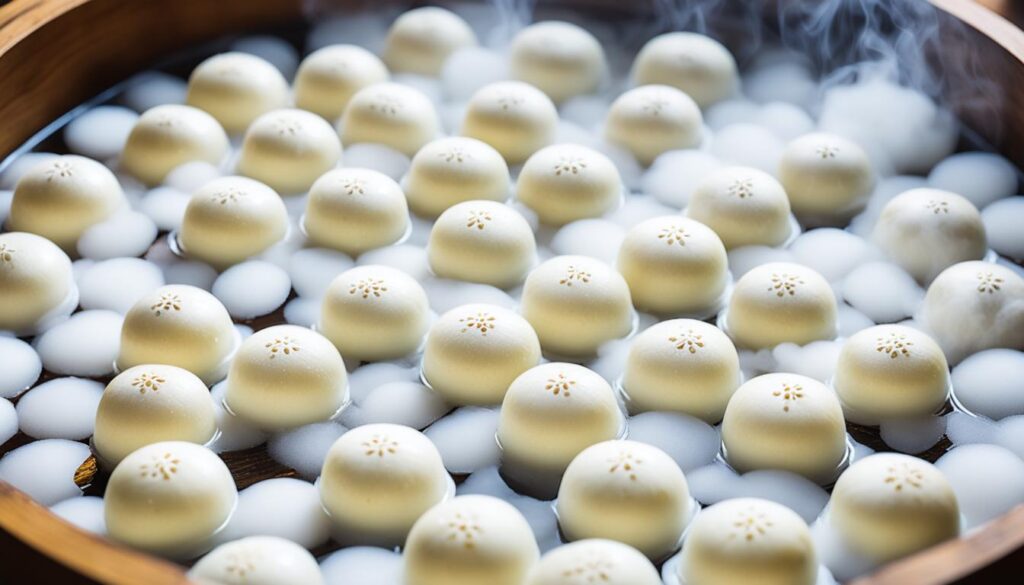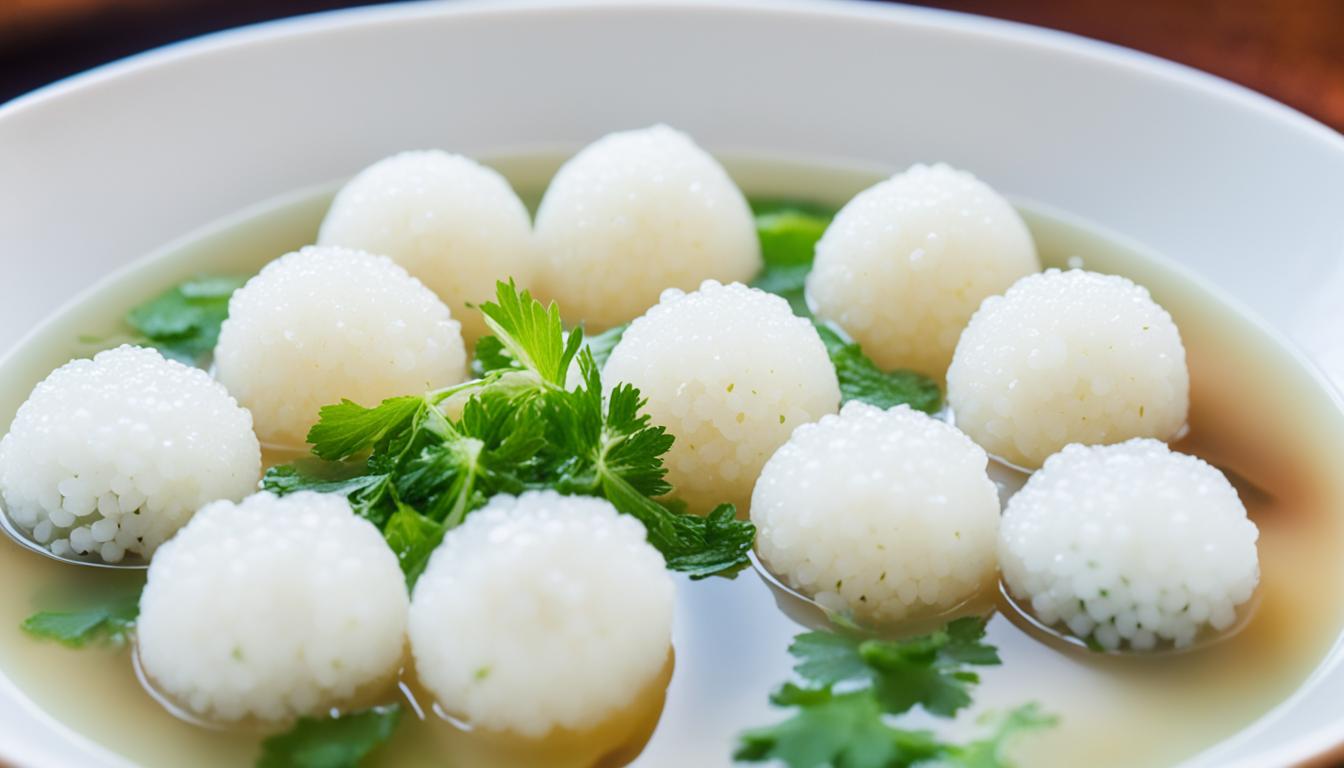Have you ever wondered how to make those adorable and delicious glutinous rice balls called Tang Yuan? Or perhaps you’re curious about the cultural significance behind this traditional Chinese dessert? Join us as we unravel the secrets of Tang Yuan, from its origins and symbolism to different variations and regional specialties.
Whether you’re a fan of sweet rice balls, looking to expand your culinary repertoire, or simply intrigued by the fascinating traditions and stories behind iconic desserts, this article will satisfy your curiosity and leave you craving a warm bowl of Tang Yuan soup.
Key Takeaways:
- Learn the origins and significance of Tang Yuan in Chinese culture.
- Discover the traditional fillings and variations of Tang Yuan.
- Find out how to make Tang Yuan from scratch.
- Explore different ways to serve and enjoy this delightful dessert.
- Uncover Tang Yuan’s cultural significance in China and its regional variations.
The Origins and Significance of Tang Yuan
Tang Yuan, also known as Yuan Xiao or Chinese glutinous rice balls, has deep roots in Chinese culture, with a history spanning over 2,000 years. This delightful dessert holds great significance and is closely associated with various Chinese festivals, including the Lantern Festival, Chinese New Year, and the Winter Solstice Festival.
The round shape of tang yuan carries a symbolic meaning of togetherness, unity, and reunion. It represents the concept of family and community coming together to celebrate these joyous occasions. The act of sharing tang yuan during family gatherings is believed to bring good luck, prosperity, and happiness in the coming year.
Chinese festivals provide an opportunity for loved ones to reconnect, and tang yuan plays a vital role in fostering this sense of togetherness. The inclusion of tang yuan as a traditional dessert at these festivals highlights its cultural significance and the importance of family values in Chinese society.
The symbolism of tang yuan extends beyond its shape and presence at festivals. It represents the cherished values of family, unity, and the desire for a harmonious life. By sharing a bowl of tang yuan, individuals strive to strengthen their family bonds and express their hopes for a prosperous future.
Traditional Tang Yuan Fillings and Variations
Traditional tang yuan is known for its delicious fillings, offering a variety of sweet and savory options to satisfy different taste preferences. The most popular filling is the rich and aromatic black sesame paste. Made from black sesame seeds, sugar, and a touch of fat for added creaminess, this filling creates a delightful contrast to the chewy glutinous rice balls.
| Tang Yuan Fillings | Description |
|---|---|
| Black Sesame | A popular choice with its rich and nutty flavor. |
| Red Bean Paste | A classic sweet filling with a smooth and velvety texture. |
| Peanut | A crunchy and slightly sweet filling for a delightful surprise. |
| Nutella | A modern twist with a creamy and indulgent chocolate-hazelnut filling. |
Tang yuan can also be made with various flavors and colors, adding a fun and playful element to this traditional dessert. From fruity flavors like strawberry and mango to matcha green tea and even pandan, the possibilities are endless. These variations make tang yuan not only a delicious treat but also a visually appealing one.
Whether you prefer the classic flavors or want to try something new and unique, the variety of traditional tang yuan fillings and variations ensures there’s a flavor for everyone to enjoy.
How to Make Tang Yuan from Scratch
Making tang yuan from scratch is a rewarding culinary experience that allows you to create this beloved Chinese dessert right in your own kitchen. By following a few simple steps, you can make tang yuan dough, prepare the filling, assemble the tang yuan balls, and cook them to perfection. Let’s dive into the process!
Gather Your Ingredients
Before getting started, make sure you have all the necessary ingredients on hand. Here’s what you’ll need:
- Glutinous rice flour
- Water
- Filling ingredients (such as black sesame seeds, sugar, and fat)
Prepare the Filling
To create the delicious filling for your tang yuan, you’ll need to combine black sesame seeds, sugar, and fat until you achieve a lava-like consistency. This filling will provide a burst of flavor when you bite into the tang yuan later.
Create the Tang Yuan Dough
Begin by combining glutinous rice flour with boiling water in a mixing bowl. Gradually add the water while stirring until a soft, smooth dough forms. If the dough feels too dry, add a small amount of water. Conversely, if it feels too wet, add a bit more glutinous rice flour. Knead the dough until it becomes elastic and pliable.
Assemble the Tang Yuan Balls
Take a small piece of dough and flatten it in the palm of your hand. Place a teaspoon of filling in the center and wrap the dough around it, sealing the edges to form a ball. Repeat this process until all the dough and filling are used.
Cooking the Tang Yuan
Bring a pot of water to a boil and gently drop the tang yuan balls into the boiling water. Cook them until they float to the surface, which typically takes about 5-7 minutes. Once cooked, remove the tang yuan from the water using a slotted spoon and transfer them to a serving bowl.
Serving the Tang Yuan
Tang yuan can be served in a sweet broth or syrup, adding an extra layer of flavor and moisture. Common serving options include ginger syrup or a thick syrup made of dark brown sugar. Garnish with your favorite toppings like crushed peanuts or sesame seeds for a delightful texture.
Now that you know how to make tang yuan from scratch, it’s time to get creative in the kitchen and enjoy this delightful Chinese dessert. Whether you’re making tang yuan for a festive celebration or simply to satisfy your sweet tooth, this homemade treat is sure to impress your family and friends. Happy cooking!
Serving and Enjoying Tang Yuan
When it comes to serving tang yuan, there are various ways to enjoy this delightful dessert, depending on regional preferences. The simplicity of the presentation allows the flavors and textures of the tang yuan to shine.
The most common method is to add a small amount of cooking liquid to the bowl to keep the tang yuan warm and the filling runny. This not only enhances the taste but also gives the tang yuan a comforting texture. There are several options for the cooking liquid, which can be tailored to individual taste preferences.
Popular Tang Yuan Broths:
| Ginger Syrup | Dark Brown Sugar Syrup |
|---|---|
| Warm and fragrant, ginger syrup adds a subtle spiciness to the tang yuan, complementing the sweetness of the filling. | A rich and indulgent option, the dark brown sugar syrup infuses the tang yuan with a deep, caramelized flavor. |
Tang yuan can also be served with a topping of your choice, adding an extra layer of flavor and texture. Common toppings include toasted sesame seeds, finely chopped nuts, or a sprinkle of coconut flakes. These toppings not only add crunch but also provide a delightful visual appeal to the dish.
For those who enjoy experimenting with flavors, tang yuan can be paired with other syrups or sauces, such as matcha syrup or a drizzle of condensed milk. These variations allow for endless creativity and can cater to different taste preferences.
When it comes to storage, tang yuan can be frozen and kept in the freezer for up to 2 months, allowing you to enjoy this delectable dessert whenever you desire. Freezing does not affect the texture or flavor of the tang yuan. To enjoy the frozen tang yuan, simply reboil them without defrosting, and they are ready to be savored once again.

The Art of Tang Yuan Presentation
The presentation of tang yuan is an art form in itself, and it is a tradition to appreciate both the taste and the visual appeal. Placing the tang yuan in the center of the bowl adds a touch of elegance, ensuring that each bite is a delightful experience.
Whether you choose to serve tang yuan for a festive celebration or a cozy family gathering, it is a dessert that is sure to impress and bring joy to everyone around the table.
Tangyuan and its Cultural Significance in China
Tangyuan holds immense cultural significance in China, representing the values of togetherness, unity, and reunion. This traditional Chinese dessert is closely associated with several important festivals, including the Lantern Festival, Chinese New Year, and the Winter Solstice Festival.
“The round shape of tangyuan represents wholeness and completeness, making it a symbol of good luck and prosperity.”
During these joyous celebrations, families come together to feast on tangyuan, fostering a strong sense of community and shared heritage. The act of sharing and enjoying tangyuan reinforces family bonds and creates lasting memories.
The round shape of tangyuan also carries symbolic meaning. The shape represents wholeness and unity, reflecting the desire for a harmonious and complete life. It serves as a powerful symbol of togetherness and acts as a talisman for strengthening familial ties.
In Chinese culture, tangyuan is not simply a dessert but an embodiment of love, respect, and kinship. It holds a special place in the hearts of the Chinese people and plays a vital role in celebrating cultural traditions.
Tangyuan and its Regional Variations
When it comes to tangyuan, the beloved Chinese glutinous rice balls, there are regional variations that offer a diverse range of tastes and textures. Let’s explore the differences between the northern-style tangyuan, known as yuanxiao, and the southern-style tangyuan.
Northern-Style Tangyuan (Yuanxiao)
In the northern regions of China, tangyuan is usually referred to as yuanxiao. This style of tangyuan is typically served in a thick and flavorful broth. Yuanxiao is known for its sweet and solid fillings that burst with delightful flavors.
Yuanxiao is traditionally enjoyed during the Lantern Festival, a festival that marks the end of the Lunar New Year celebrations. It is a time for families to come together and share this delicious dessert as a symbol of unity and togetherness.
Southern-Style Tangyuan
The southern regions of China have their own style of tangyuan, simply known as tangyuan or tangtuan. Unlike the northern-style, the southern-style tangyuan is served in a thinner soup.
One of the distinct features of southern-style tangyuan is its wide variety of sweet and savory fillings. From classic flavors like black sesame paste and red bean paste to innovative options like matcha and taro, there is something to suit everyone’s taste buds.
The southern-style tangyuan is enjoyed throughout the year and is especially popular during festivals like the Winter Solstice and Chinese New Year. It is a time for families to gather around, savoring these delightful glutinous rice balls and celebrating the joy of togetherness.

Tangyuan in Asian Cuisine
Tangyuan, a traditional Chinese dessert, has made its way into various Asian cuisines, with each culture adding its own unique twist to this beloved treat.
In Japan, a similar dessert known as daifuku-mochi is a popular choice. Made with glutinous rice and filled with sweet anko paste, daifuku-mochi offers a delightful burst of flavor in every bite.
In Indonesia, wedang ronde takes center stage. This vibrant dish features round colored balls of glutinous rice filled with crushed peanuts and sugar, served in a ginger broth. The combination of sweet and nutty flavors creates a delicious and comforting experience.
Malaysia has its own version called buah Melaka. These glutinous rice balls are filled with sweet gula Melaka, or palm sugar, and served with coconut shavings. The rich flavor of the palm sugar and the fragrant coconut complement each other perfectly.
Myanmar serves a festive dish called mont lone yay paw during Thingyan. These tangyuan-like treats are filled with jaggery and served with coconut shavings, offering a delightful combination of sweetness and texture.
In the Philippines, you can find tangyuan-inspired desserts that showcase the ingenuity of Filipino cuisine. These desserts incorporate local ingredients and flavors, putting a unique twist on the traditional Chinese treat.
As you can see, tangyuan has transcended borders and become a beloved dessert in many Asian cultures. Each country adds its own flavors and ingredients, resulting in a diverse and delicious range of tangyuan-inspired creations.
Tips and Troubleshooting for Making Tang Yuan
Making tang yuan can be a fun and rewarding experience, and we want to ensure your tang yuan turns out perfect every time. Here are some important tips and troubleshooting advice to help you along the way:
1. Prepare the Filling First
Before you start making the tang yuan dough, it’s a good idea to prepare the filling. This allows the filling to cool down and set before filling the dough, making the assembly process easier and preventing the filling from melting inside the dough.
2. Adjust Dough Consistency as Needed
The consistency of the dough is crucial for making smooth and pliable tang yuan. If the dough is too dry and crumbly, add a little more water. If the dough is too sticky and wet, add a small amount of glutinous rice flour. Gradually adjust the consistency until you have a soft and elastic dough that is easy to work with.
3. Use Natural Ingredients for Coloring
If you want to add color to your tang yuan, it’s best to use natural ingredients like matcha powder, beetroot juice, or purple sweet potato puree. These natural coloring options not only add vibrant hues to your tang yuan but also provide a subtle flavor profile that complements the fillings.
4. Freezing Tang Yuan
If you want to make tang yuan in advance or have leftovers, you can freeze them for later use. Place the uncooked tang yuan on a parchment-lined baking sheet and freeze until firm. Transfer the frozen tang yuan to an airtight container or freezer bag and store them in the freezer for up to 2 months. To cook the frozen tang yuan, simply drop them directly into boiling water without defrosting.
5. Troubleshooting Cracked Dough
If you encounter cracked dough while shaping the tang yuan balls, don’t worry! Simply wet the broken part of the dough with water and gently press and reseal it. The moisture will help the dough stick together, and the crack will disappear once the tang yuan is cooked.
6. Adjusting Dough Texture
If you find that the dough is too dry and difficult to shape, add a small amount of water and knead it until the dough becomes more pliable. On the other hand, if the dough is too sticky and hard to handle, sprinkle a little glutinous rice flour and knead it into the dough until it reaches the desired texture.
7. Proper Tang Yuan Storage
To keep your tang yuan fresh and prevent them from drying out, store them properly. After cooking, transfer the tang yuan to a bowl of cold water to prevent sticking. To store them for later use, drain the tang yuan well and place them in an airtight container. Refrigerate for up to 2-3 days, but remember to consume them as soon as possible for the best texture and taste.

| Tips | Troubleshooting |
|---|---|
| Prepare the filling first | Fix cracked dough by wetting the broken part with water and resealing it |
| Adjust dough consistency as needed | Adjust the dough texture by adding more water or flour as needed |
| Use natural ingredients for coloring | |
| Freeze a batch for later use |
Remember to follow these tips and troubleshooting advice to ensure your tang yuan turns out delicious and visually appealing every time you make them. With practice and a little creativity, you’ll be able to create beautiful and mouthwatering tang yuan to share with family and friends.
Glutinous Rice Balls Tang Yuan Recipe
Are you ready to embark on a culinary adventure and create your own delicious glutinous rice balls tang yuan? Follow our step-by-step recipe to make this traditional Chinese dessert that will surely delight your taste buds. Whether you’re a seasoned chef or a beginner in the kitchen, this recipe is easy to follow and guarantees scrumptious results.
Ingredients:
- 2 cups glutinous rice flour
- Water (for dough and cooking)
- For the filling:
- Black sesame paste, red bean paste, or your preferred sweet filling
- For the broth (optional):
- Ginger syrup or dark brown sugar syrup
Instructions:
- In a mixing bowl, combine the glutinous rice flour with water gradually until a soft, pliable dough forms. Knead the dough until it becomes smooth and elastic.
- Take small portions of the dough and roll them into small balls approximately 1 inch in diameter.
- Flatten each ball using your thumb and place a teaspoon of the desired filling in the center.
- Seal the edges of the dough by pinching them together, ensuring the filling is completely enclosed within the dough.
- Bring a pot of water to boil and carefully add the glutinous rice balls to the boiling water. Stir gently to prevent sticking.
- Cook the glutinous rice balls until they float to the surface, which usually takes about 3-5 minutes.
- If desired, prepare a sweet broth by combining ginger syrup or dark brown sugar syrup with water in a separate pot and heat until warm.
- Remove the cooked glutinous rice balls from the boiling water using a slotted spoon and transfer them to serving bowls.
- Pour the sweet broth over the tang yuan, and they are ready to be enjoyed.
- Alternatively, you can serve the tang yuan without the broth, and they will still be delicious!
Get creative with your tang yuan by experimenting with different fillings and serving options. From traditional black sesame paste to delightful variations like peanut filling or Nutella, the possibilities are endless. Whether you prefer them in a sweet broth or simply on their own, these homemade glutinous rice balls will surely be a crowd-pleaser.
Conclusion
We have seen that tang yuan is not just a delicious dessert but also a sweet tradition with deep cultural significance. This festive dessert, made of glutinous rice flour and filled with sweet or savory fillings, is a favorite during family celebrations and traditional Chinese festivals.
Symbolizing unity, togetherness, and reunion, tang yuan brings joy and warmth to gatherings. Whether served in a sweet broth or syrup, its round shape and flavorful fillings delight both young and old. Its gluten-free and vegetarian/vegan-friendly nature make it accessible to a wide range of dietary preferences.
Tang yuan’s rich history and cultural significance add a deeper appreciation to this beloved dessert. By understanding its origins and symbolism, we can truly savor the experience of tang yuan and the traditions it represents. So, next time you enjoy this sweet treat, take a moment to appreciate the cultural heritage and the sweet traditions associated with tang yuan.
